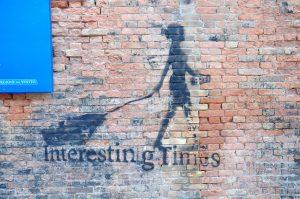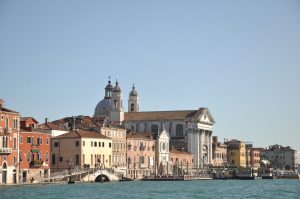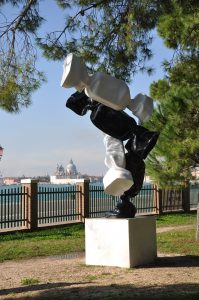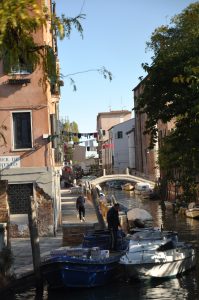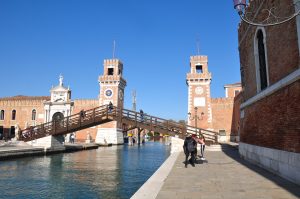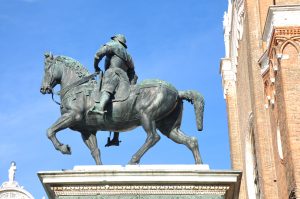I had long wanted to fully experience the Venice Biennale. In 2017, the curator of the American pavilion was Christopher Bedford, also the newly hired director of the Baltimore Museum of Art. The credentials created quite the synergistic buzz. The artist who represented the United States was Mark Bradford from Los Angeles, California; a version of that exhibition arrived eventually at the BMA. Pretty interesting stuff, I thought.
In my mind, the Biennale was something that occupied the torpid months of summer when I avoid traveling in Europe—or any tourist locale—at all. I had not realized—and it’s really inexcusable for an arts professional like myself—that the Biennale opens in mid-May and closes the last weekend in November. Except for this year. Acqua alta starting around November 11 forced everything shut by November 18.
Getting There
At any rate, when I realized thanks to signs all over the city that the Biennale, with the theme “May You Live In Interesting Times,” runs for six months in odd-numbered years, I knew what I wanted to do. Sort of. I wanted to see the Lithuanian pavilion which I knew had won the Golden Lion prize and I wanted to explore the Castello, and especially the leafy precincts of the Giardini della Biennale.
The Biennale, in fact, is spread throughout the city. Signs up and down the Grand Canal advertise this artist or that event, and the art involves performance, theater and music as well as visual mediums. Neither I nor my Dear One had the fortitude or the feet to cover even a quarter of the venues so we largely decided on finding the Lithuanian pavilion and noting whatever else we happened to walk by.
Truth be told, I have a lousy grasp of the geography of Venice. I get lost incessantly. Finding a particular address is mostly a matter of luck. My ignorance of that place was reiterated as we strolled on that lovely warm day down the rivas toward the Giardini, which is to say toward the treetops we could see above buildings in the distance. We disembarked from the vaporetto (which took the lagoon route from Tronchetto where the car was parked) in the general vicinity of San Zaccaria. We had visited the eponymous church in 2009; this was as far east in Venice as we had ever been.
Having arced over four or five bridges, we arrived at the area covered by “Exploring Eastern Castello” in the DK Eyewitness Travel guide to Venice & The Veneto. We passed the grand expanse of the via Giuseppe Garibaldi, with its shops and cafés and bars and osterias and people and came upon some small green areas that comprise the Giardino della Marinaressa of the Parco Pubblico system. Bright, shiny sculptures, modern, a little abstract, definitely colorful and whimsical. The sun was beginning to beat down so the shady paths were welcome. And it’s fun to take pictures of colorful, whimsical sculpture.
May You Live In Interesting Times
Eventually we entered the Giardini della Biennale. After studying the graphically attractive and functionally useless maps posted here and there on triangular posts, we decide to head away from the lagoon and toward the Arsenale where the Lithuanian pavilion was purportedly located at Magazzino n. 42, Marina Militare, Arsenale di Venezia, Fondamenta Case Nuove 2738/C (near Campo de la Celestia). Viale Giuseppe Garibaldi—not to be confused with the via Garibaldi—offered a wide avenue under a canopy of foliage and pointed in approximately the correct direction, so off we went, into a blitz of pigeons flying so close to us we could feel their wingbeats and see their beady little eyes. Wave after wave they came, a little threatening and rather thrilling.
We passed a few exhibition spaces and took a look. The ongoing problem—for me—with very contemporary work is twofold. First, it tends to require lengthy explanatory panels if one is to decode the often-inscrutable installations. Second, those text panels are themselves largely unintelligible. Artists are almost never writers and the gallerists and associated art folk who put the verbiage together can rarely write coherently and almost never can summarize the artists’ intentions in a single intelligible sentence. It’s a problem. In my fantasy world, though, I am invited to transform that gobbledygook into standard English. And paid for doing it.
Beyond the Biennale
We paused for lunch in the campo del’Arsenale, to rest, fortify ourselves and figure out where the heck the Lithuanian pavilion was from there. Dealt with more pigeon attacks, these assaults focused on control of the basket of rolls and bread sticks on our table. After a plate of insalata caprese and a bowl of minestrone for me and spaghetti al nero di seppie for my Dear One, and a half-liter of red wine, we were ready to renew the search.
Ultimately, we encountered a British couple also searching for the Lithuanian pavilion who said they found it closed. A nice young street cleaner who spoke very good English confirmed that the exhibition had ended on November 1. Rats.
From there we ambled in the general direction of the Rialto bridge, past the Chiesa della San Francesco della Vigna to the Basilica dei Santi Giovanni e Paolo, with its wonderful equestrian statue of Bartolomeo Colleoni and past Santa Maria dei Miracoli on the edge of our old stomping grounds in Cannaregio. We caught a vaporetto and bid a melancholy arrivederci to La Serenissima.
We didn’t see much of the visual art and there was no opportunity to buy tickets to any of the performances. But I know what a better approach is; spend two weeks in Venice in September or October with plans to do little else other than hit the venues and eat. An agenda with perfectly compatible goals.

